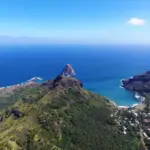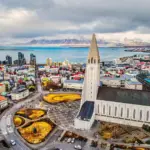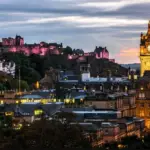
Exploring the Stunning Danakil Depression: Extreme Geology and Unforgiving Climates
THE Danakil Depression, Also known as Dallol, it stands out as one of the most extreme geological and climatic landscapes on our planet. Located in northeastern Ethiopia, in the Horn of Africa, this unique region offers an authentic geological and climatic experience. With its active volcanic formations, vast salt flats, and unforgiving climate, the Danakil Depression captivates adventurers eager to discover the natural wonders of our world.
Discovering Geographic Location
The Danakil Depression lies at the convergence of the African and Arabian tectonic plates, creating a constantly changing geological landscape. Situated between the Red Sea and the African Rift Valley, this strategic location makes it a center of scientific interest for researchers and geologists. Upon entering this depression, visitors are immersed in a truly extraordinary environment.
Bordered to the north by the imposing Erta Ale Massif, a volcanic mountain range, and to the south by the Habesha Mountains, this depression is characterized by vast salt flats crisscrossed by deep tectonic fissures that tear through the Earth's crust. This unique combination of geographic features evokes a mystical and surreal atmosphere when exploring this remote region.
Unraveling the Extreme Experience
The Danakil Depression is notorious for its extreme weather conditions, posing a challenge for adventurers wishing to explore this arid territory. The average annual temperature ranges between 35°C and 45°C, with peaks exceeding 50°C in the hottest months. Furthermore, the scarcity of rainfall in this region contributes to a dry and desolate environment. However, it is these adversities that give the Danakil Depression its stunning uniqueness.
The high temperatures create the opportunity to witness rare geological phenomena, including active volcanoes and incandescent lava lakes. The contrasting color palette between the dark volcanic rocks and the multicolored salt formations provides a breathtaking visual spectacle.
Explore this extreme environment requires adequate preparation and professional guidance to ensure safety throughout the journey. After all, despite being a unique experience in geological and aesthetic terms, the Danakil Depression demands the utmost respect for the unforgiving nature that has sculpted this extraordinary landscape over the millennia.
Overview of the Danakil Depression
The Earth in Boiling: Volcanoes, Tectonic Rifts and Salt Flats
The Danakil Depression is a geologically remarkable region, comprised of a diversity of unique features. Within it, active volcanoes spew incandescent lava into the sky, creating breathtaking natural spectacles.
The most iconic volcano is Erta Ale, whose name translates as "smoking mountain." Its crater houses a boiling lake of lava, releasing sulfurous gases and creating a surreal sight.
In addition to the volcanoes, the depression features impressive tectonic rifts formed over time by the movement of tectonic plates. These rifts reveal nature's ingenuity and offer visitors a fascinating glimpse into geological processes in action.
Another notable feature is the vast salt flats that stretch across the region. These flats are the result of the evaporation of ancient lakes over the centuries, leaving behind a brilliant white landscape.

Climate Challenges: An Inhospitable Terrain
Exploring the Danakil Depression means facing extreme weather conditions that test the limits of human endurance. The region is famous for its scorching temperatures, which can easily exceed 50°C.
This intense heat wave is a consequence of the lack of shade and the predominance of volcanic rocks that absorb and retain solar heat. The region's unique topography, with parts reaching negative altitude, contributes to the depression's arid and dry climate. The hot winds sweeping through the valley further intensify the thermal sensation, challenging visitors who venture into this inhospitable landscape.
Reflections on the Fragility of Life
The Danakil Depression immerses us in an extreme environment where life seems nearly impossible. In this desolate and hostile landscape, we are confronted with the fragility of living beings in the face of the brutal forces of nature.
This region invites us to reflect on our own vulnerability to the elements and makes us question our role as human beings in this vast planetary ecosystem. By courageously exploring these arid and dangerous lands, we can develop a deep respect for life's resilience and a greater appreciation for the unique beauty that emerges even in the most adverse conditions.

The Active Volcanoes of the Danakil Depression
Exploring Erta Ale: A Portal to the Depths of the Earth
Erta Ale is one of the most iconic and active volcanoes in the Danakil Depression. Its unique formation, characterized by a large caldera housing a boiling lava lake, fascinates scientists and adventurers alike. At approximately 613 meters above sea level, Erta Ale offers a breathtaking view to those who venture to explore its steep slopes.
The constantly moving lava lake creates a surreal and mesmerizing landscape, where brilliant colors dance beneath the starry night sky. Volcanic energy emerges from deep within the Earth, reminding us of the awe-inspiring power present within our planet.
Discovering Dallol: A Journey Through Alien Landscapes
Located north of the Danakil Depression, Dallol captivates visitors with its truly alien landscapes. This unique volcanic area is known for its colorful hot springs and bubbling acid pools, which seem to have emerged from a fever dream. The vibrant hues of the saline waters contrast with the peculiar geological formations around them, creating an unparalleled visual spectacle.
Intense geothermal activity fuels the mineral wealth, resulting in the formation of unique crystalline structures that evoke otherworldly sculptures. Exploring Dallol is like entering a surreal reality where nature reveals its most extravagant expression.
The Force of Nature: Frequent Eruptions and Their Importance
The Danakil Depression is famous for its frequent volcanic eruptions. These eruptions are the result of the movement of tectonic plates along the Great Rift Valley, a vast geological rift that runs through the African continent. Volcanic eruptions not only shape the depression's landscape but also play a crucial role in global geological processes.
They release gases and particles into the atmosphere, affecting the climate and contributing to the formation of new fertile soils. Furthermore, studies conducted in these areas help scientists better understand volcanic processes and provide valuable information for preventing and mitigating volcano-related natural disasters.
Conclusion
The Danakil Depression is a veritable geological wonder that offers a fascinating glimpse into the Earth's inner forces. The active volcanoes of this wilderness are like magical portals to an unknown world, where boiling lava and surreal landscapes spark our imagination.
Erta Ale, with its lava lake, and Dallol, with its unique crystalline formations, bear witness to the extraordinary nature of our planet. The frequent volcanic eruptions in the Danakil Depression not only sculpt the landscape but also play a crucial role in global dynamics, providing valuable lessons for science and inspiring a deep appreciation for beauty and strength of nature.
Lucas Wanderlust has a tireless spirit of adventure, always seeking new travel experiences. Fascinated by the world and the possibility of exploring unknown destinations, he fell in love with the sense of freedom and self-discovery that traveling alone provides. With a backpack on his back and a heart open to the unknown, Lucas embarks on exciting journeys, where each destination becomes a unique chapter in his life story. He gives himself body and soul to the magic of solo travel, inspiring others to follow in his footsteps and discover themselves through adventure.







